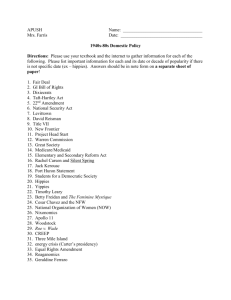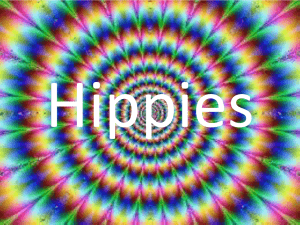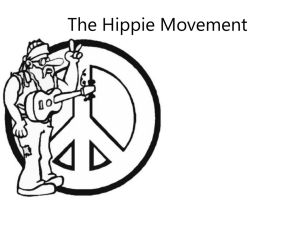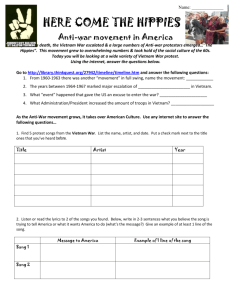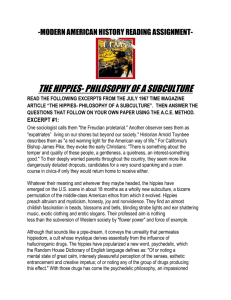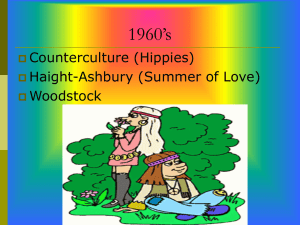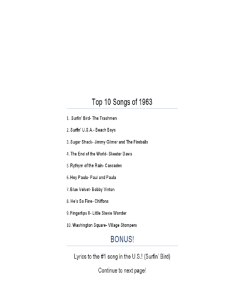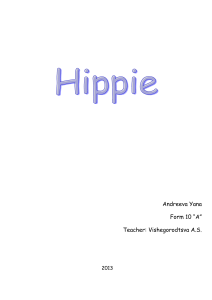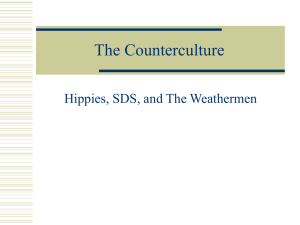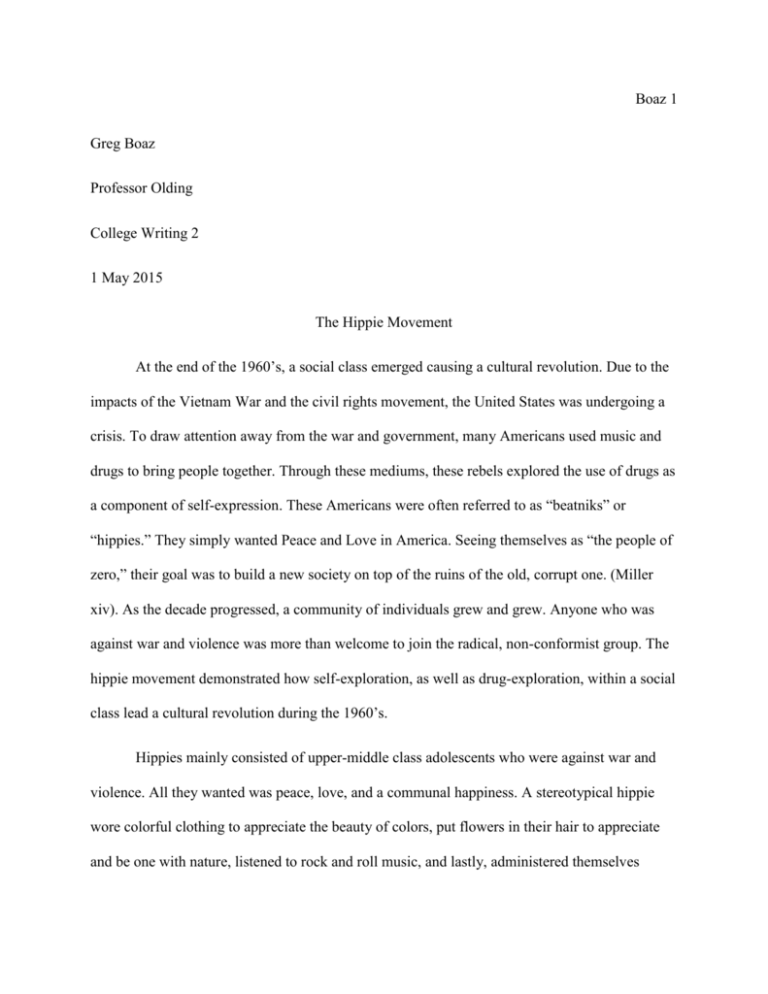
Boaz 1
Greg Boaz
Professor Olding
College Writing 2
1 May 2015
The Hippie Movement
At the end of the 1960’s, a social class emerged causing a cultural revolution. Due to the
impacts of the Vietnam War and the civil rights movement, the United States was undergoing a
crisis. To draw attention away from the war and government, many Americans used music and
drugs to bring people together. Through these mediums, these rebels explored the use of drugs as
a component of self-expression. These Americans were often referred to as “beatniks” or
“hippies.” They simply wanted Peace and Love in America. Seeing themselves as “the people of
zero,” their goal was to build a new society on top of the ruins of the old, corrupt one. (Miller
xiv). As the decade progressed, a community of individuals grew and grew. Anyone who was
against war and violence was more than welcome to join the radical, non-conformist group. The
hippie movement demonstrated how self-exploration, as well as drug-exploration, within a social
class lead a cultural revolution during the 1960’s.
Hippies mainly consisted of upper-middle class adolescents who were against war and
violence. All they wanted was peace, love, and a communal happiness. A stereotypical hippie
wore colorful clothing to appreciate the beauty of colors, put flowers in their hair to appreciate
and be one with nature, listened to rock and roll music, and lastly, administered themselves
Boaz 2
drugs. According to Anderson, hippies “blew bubbles, wore beads and bells, looked into
distorted mirrors, and chalked colorful designs on sidewalks” (94). They dressed flashy, did
drugs, protested against the war, and created a community of freedom, but why? Their intentions
were simple: leave society utterly, do your own thing, and blow the mind of any straight person
by turning them on to beauty, love, honesty, drugs and fun (Miller xv). The hippies did not trust
society or the government and did not want to conform to the norm. With the country at war, the
civil rights movement, and push for idealism, they wanted change. Music and drugs brought
together the young group of rebels because they both expressed freedom from conformity (What
is a Hippie?).
The rise of the hippie community mainly took place in the district Haight-Ashbury of San
Francisco, California during a time often referred to as “The Summer of Love.” In 1967, this
district became a destination for any non-conformist to arrive in open-arms to express peace and
love. Haight-Ashbury became a place where one could be who they wanted to be and act how
they wanted to act, free of judgements. Growing up, these individuals were given a set of values
from their family and society in general. They realized how society doesn’t live up to many
values, which enabled them to go to Haight-Ashbury. In the documentary, Revolution, a man
being interviewed explained that hippies went to Haigh-Ashbury for a personal philosophy and
satisfaction to find out why we are here, on earth, in the first place. Most of society questioned
this through trial and error, but the hippie’s trial and error was associated with drug use; mainly
marijuana and acid. (O’Connell).
One of the communal drugs that the hippies used was Lysergic acid diethylamide (LSD),
often referred to as acid. In the documentary, Revolution, a hippie girl explained how acid
Boaz 3
intensifies everything one perceives. One will become more sensitive to the world, people,
sounds, colors, and beauty in general (O’Connell). The hippies took acid to connect with one
another on a psychedelic level to appreciate the beauty of reality. Along with acid, being sold
openly on the street corners of San Francisco in 1967, marijuana was heavily pressured to be
used among society. These drugs were used in the decade to open the young minds of individuals
in order to appreciate the beauty of life and love. The hippies invited anyone to come get high on
drugs and listen to music together, as a group. No matter what one’s background or ethnicity
was, they were welcomed with open arms. (O’Connell).
Music was a main component of the hippie movement, especially the genres: rock and
roll and folk. This was part of the revolution because many upcoming bands at the end of the
1960’s expressed anti-conformity and the use of drugs. Folk bands were popular among hippies
due to the music’s search of community, nature, and health. Popular folk artists such as the
Byrds, Bob Dylan, and the Grateful Dead “revised country, folk, and country music in down-toearth albums that substituted traditional sounds and iconography for psychedelic
experimentation” (Moore 43). Rock bands, such as the Beatles, Rolling Stones, The Who,
Jefferson Airplane, and Jimi Hendrix, became a voice for the hippies because many songs
discussed the struggles of the Vietnam War. America was in shock due to the United States army
dying off in drastic numbers. Along with the United States army struggling, horrifying images of
happenings in Vietnam were broadcasted for the American public to see (Anderson 101-102).
This frightened and angered many Americans, especially the hippies. Rock and Roll became a
voice for the generation to protest against the war. A famous song that emerged from this crisis
was “The Vietnam Song” by Country Joe and the Fish. This song became an anthem for the
Boaz 4
hippies, exaggerating how entering Vietnam would tear down America and kill us all. As seen in
the lyrics, “And its 1,2,3 what are we fightin for? Don't ask me I don't give a dam, the next stop
is Vietnam” (Country Joe and the Fish, “The Vietnam Song”), Country Joe explains how society
is clueless as to why we decided to go to war. Later in the chorus, he implies that we all are
going to die, but who cares? This song explained how hippies practiced freedom and communal
unity, while the Vietnam War contradicted their beliefs, separating a nation. Many other bands
wrote songs about the war, anti-conformity, peace, love, and drugs, which altogether added to
the hippie culture. According to Anderson, “music festivals were a “gathering of the tribe,”
freaks coming together to do their own thing – beyond the norms and laws of mainstream
society” (142). Monterey Pop Festival, Altamont, and Woodstock were the three most notable
hippie music festivals that demonstrated not only peace and love, but also the destructive,
childish behavior and heavy use of drugs for the youthful rebellion.
During the climax of the Summer of Love in 1967, a music festival titled The Monterey
Pop Festival was held that labeled the Summer of Love with music, peace, and love. Held on a
farm over a three day window, bands from all over the country came to play at the event. It
became the first American Rock Festival introducing big bands such as Jimi Hendrix, Janis
Joplin, the Who and the Grateful Dead. The rock festival was a success for the hippie movement.
The concert was incredibly peaceful and influenced people to get into the spirit of spreading
peace and love. Even local police chiefs were said to have sent half of their forces home as well
as decorate their motorcycles with flowers (Anderson 97). This showed that the concert was
bringing everyone together; exactly what it intended. No problems arose regarding violence or
drug-use. This was mainly due to the organization committee’s job of putting the festival
Boaz 5
together. Looking over weather conditions, food, water, and safety, the concert was designed for
everyone to be safe and enjoy the music. They took many precautions, such as hiring volunteers
to manage episodes of those who took psychedelic drugs. These precautions later influenced the
organization of the most iconic music festival of the 1960’s: Woodstock. (Monterey Pop Festival
Reaches Its Climax).
The Woodstock Music Festival was organized by four young men, the oldest only being
27 years of age. They originally wanted to invest money in a recording studio to foster upcoming
rock bands, but the idea transformed into organizing three days of music, peace, and love. As the
organization committee planned for the concert, they encountered many obstacles that slowed
them down. First, the venue was changed to a different location; a month short of the concert.
This was due to a law being passed in Wallkill, New York that banned the concert from being
held in the vicinity. Luckily, a farmer named Max Yasgur offered his dairy farm to be the
location of the venue. This unfortunately set the planning time back, resulting in less time to plan
for the festival. Two days before the festival began, around fifty thousand hippies started setting
up camp at the venue where the gates were supposed to be built. Not being able to make the fifty
thousand people leave or charge them to get in, they were forced to make the event a free
concert. This choice resulted in more people attending the festival. Only expecting around two
hundred thousand people to attend, roughly half a million showed up. This became very chaotic
for the organizers because they failed to obtain enough food, water, concessions, and toilets to
support the enormous crowd. Still by missing several precautions to safely run the festival, the
music event started on the expected date, but the organization committee was over one million
dollars in debt (Rosenberg). (Brandeis)
Boaz 6
Woodstock served as a moment of history for the hippie movement. The whole concert
was centered around peace, love, nature, and community. What more could a hippie ask for? A
free concert full of friends, music, and drugs. The crowd was unpredictable due to drug use and
short supply of food, water, toilets, and power. Arlo Guthrie, a musician who performed at
Woodstock, explained that, “for the first time, there were so many more of us than them… it was
our moment” (Brandeis). The hippies were in power of the concert. The organization committee
actually forced bands to play longer sets in order to keep the crowd at ease. Luckily over the
three days of music and peace, only two deaths and roughly four hundred hallucinogen freakouts
occurred. But the crowd was still out of control. With not enough security to patrol the venue,
“drugs were being used openly and freely among the huge crowd and LSD was the hallucinogen
of choice” (Brandeis). Five hundred thousand intoxicated hippies sang along to music and
embraced the sense of harmony the festival offered. After the three days of peace and music
came to an end, five hundred thousand hippies proved how they could gather peacefully in an
environment full of sex, drugs, and music (The Altamont Festival Brings the 1960s to a Violent
End). But not long after Woodstock, the Altamont music festival was held that resulted in
mayhem that scared away the audience, as well as bands who were scheduled to perform.
(Brandeis).
In the December of 1969, the Altamont Speedway Free Festival was held in the name of
a band named the Rolling Stones. The Rolling Stones wanted to host a free concert to kick off
their United States tour. In attempts to recreate a Woodstock on the west coast, the Altamont
festival failed to promote peace, love, and happiness. Roughly three hundred thousand people
attended the concert. Most of them were well-mannered, but those close to the stage were
Boaz 7
violent, drunk, and stoned. This was mainly due to the Rolling Stones hiring a biker gang named
the Hells Angels to guard the stage. Paying the Hells Angels in five hundred dollars of beer, the
Stones underestimated the biker gang’s intentions throughout the festival. The biker gang
thought they controlled the concert and beat drugged kids with sticks and also harmed band
members who were to perform. The most notable act of violence during the festival was the
murder of a young black man, named Meredith Hunter, during the Rolling Stones set. The Hells
Angels stabbed him repeatedly and kicked in his face, horrifying the crowd to do nothing but
stand in shock. The Rolling Stones finished their set, unaware of the murder in front of their
eyes. The concert came to a chaotic end, overwhelming the crowd of hippies. (Anderson 144).
The Altamont Speedway Free Festival brought a violent end to the hippie movement.
According to Anderson, “Altamont disgusted hippies” (144). Altamont gave a bad name for
hippies, resulting in ridicule and discrimination for the rebellious social class. After Altamont,
America labeled festivals “as harbingers of dope, debauchery, and destruction” (Anderson 144).
Businesses all around the nation started putting up signs saying: “No shirt, no shoes, no service.”
Throughout America, police harassed those who “looked” like hippies by raiding their houses
with no search warrants. They were searching for anything to bring them down. The decade
came to an end and, “hippies had infiltrated the very foundations of the Establishmentgovernment, business, universities, religion, and even the U.S. armed forces” (Anderson 145).
With much anger, the hippies protested against the war and for the decriminalization of the drug:
marijuana. The hippies wanted to push life to the extreme, searching for a free love and high. As
the 1970’s approached, hippies were growing in number, but becoming more vulnerable. A
generation of activists emerged that dominated the nation throughout the sixties. The hippie
Boaz 8
counterculture challenged their lifestyle, trying to be different. They succeeded in leaving
mainstream society and creating one of their own to challenge the past. (Anderson 144-147).
The three music festivals, Monterey Pop, Woodstock, and Altamont, demonstrated how
music brought together hippies. From songs about drug use to anti-war protests, bands developed
a voice for the rebellious social class. The “Summer of Love” brought together a youthful
rebellion full of young individuals wanting change. Throughout the end of the 1960’s, hippies
demonstrated drug-exploration mainly with the drugs: marijuana and LSD. They took these
drugs to discover a personal philosophy and form a connection with nature. Drugs opened their
minds to appreciate beauty in life and get away from mainstream society. This also connected the
hippie movement to exploration of self. Hippies wanted change for the country. With America
encountering many struggles due to the Vietnam War, hippies simply wanted peace and love.
The rebellious revolution, full of druggies and music-lovers, brought together a nation to cope
with the end of a conflicted decade and create a counterculture to shape a new generation.
Boaz 9
Works Cited
Anderson, Terry H. The Sixties: Third Edition. 3rd ed. N.p.: Pearson Longman, 2007. Print.
Behind the Music. Dir. Jonathan Brandeis. 1999. Online
Country Joe and the Fish. “Vietnam Song”. And its 1,2,3 what are we fightin for? Don't ask me I
don't give a dam, the next stop is Vietnam. Woodstock: Music from the Original Soundtrack and
More. Atlantic Records. 1970.
Miller, Timothy. The Hippies and American Values. Knoxville: U of Tennessee, 1991. Print.
Moore, Ryan. Sells like Teen Spirit: Music, Youth Culture, and Social Crisis. New York: New
York UP, 2010. Print.
Revolution. Jack O’Connell. Today Malone. 1968. Online
Rosenberg, Jennifer. "The Woodstock Festival of 1969." About Education. N.p., n.d. Web. 27
Apr. 2015.
Staff, History.com. "The Altamont Festival Brings the 1960s to a Violent End." History.com.
A&E Television Networks, n.d. Web. 27 Apr. 2015.
Staff, History.com. "The Monterey Pop Festival Reaches Its Climax." History.com. A&E
Television Networks, n.d. Web. 27 Apr. 2015.
"What Is a Hippie?" Wonderopolis. N.p., n.d. Web. 26 Apr. 2015.
<http://wonderopolis.org/wonder/what-is-a-hippie/>.

